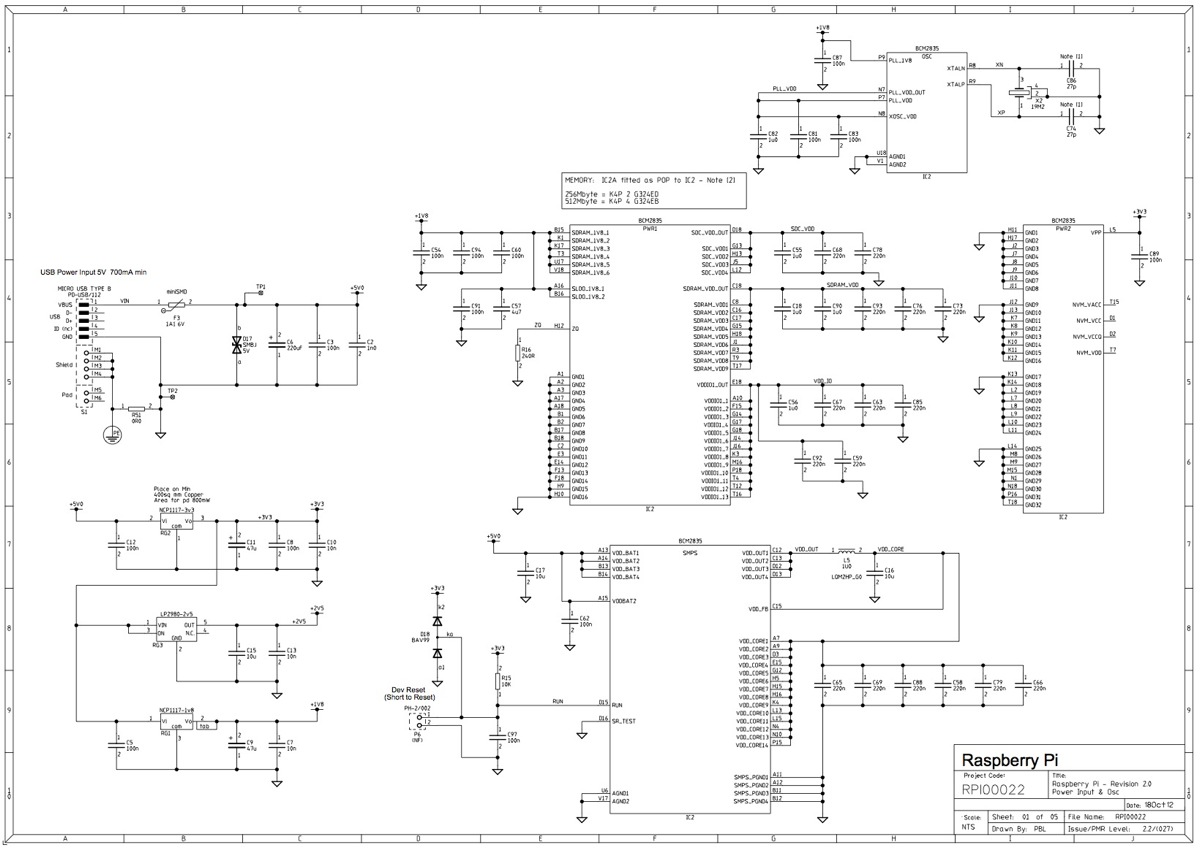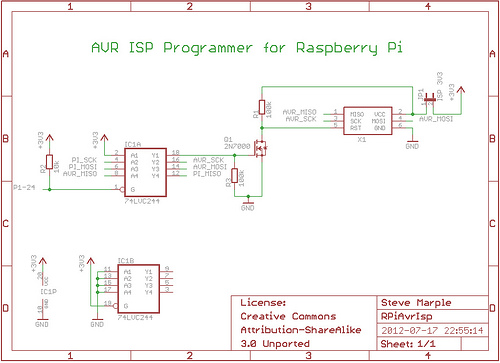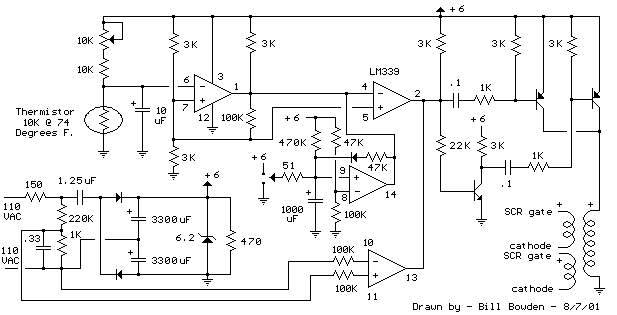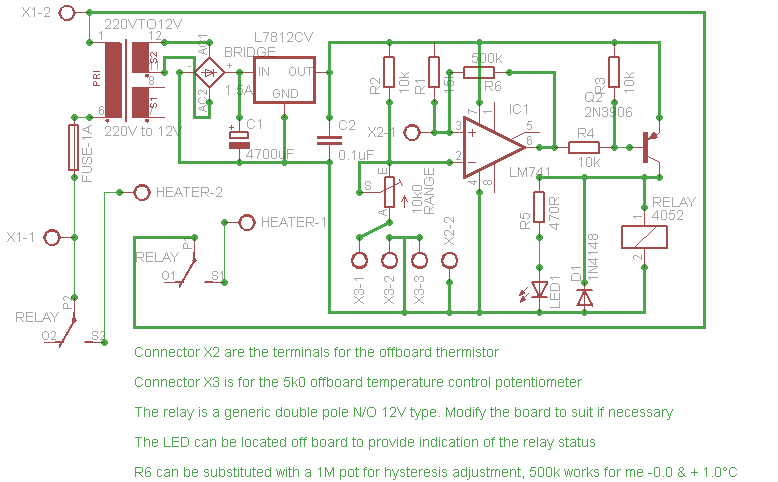
raspberry pi thermostat hookups
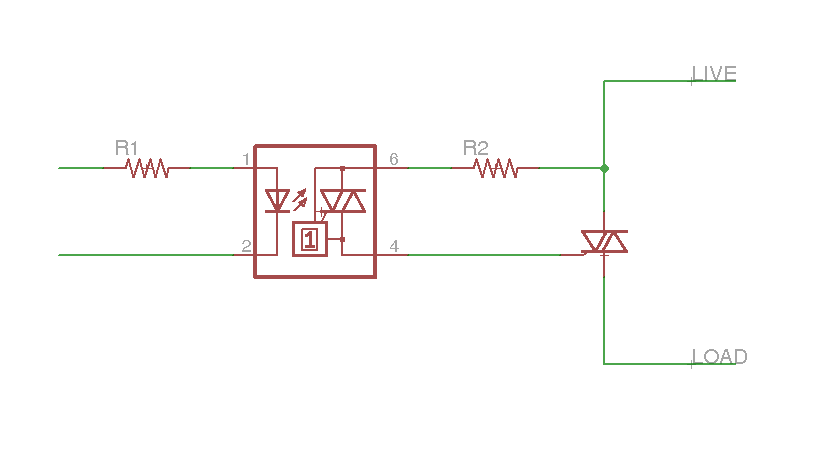
This document outlines the hardware connections between a Raspberry Pi and household wiring, specifically for controlling HVAC systems. In typical residential setups, thermostat wiring operates at 24V AC, with one or two live wires entering the thermostat and multiple wires exiting to control various HVAC components. The thermostat's function is to close the circuit between the live wire and the designated control wire based on temperature readings. Although relays can be used for this purpose, they may be cumbersome due to their pin layout and current requirements. A more efficient method for switching AC current is the TRIAC, which operates similarly to a MOSFET but is designed for AC applications. Key characteristics of TRIACs include their inability to deactivate until the current falls below a certain threshold, which is not applicable in DC scenarios. In AC systems, the voltage and current drop to zero twice per cycle, allowing for effective control. However, TRIACs cannot be switched faster than the AC line frequency and are not suitable for PWM applications. Instead, they can control the timing of activation to manage average current flow, as seen in light dimmers. The TRIAC circuit involves a three-pin device wired in series with the load, activated by a gate current. For switching significant current, an intermediary smaller TRIAC is recommended, often implemented as an opto-coupled TRIAC for added isolation from the GPIO. The circuit includes a current-limiting resistor, R1, to control the LED in the opto-coupler, and R2 to limit current through the smaller TRIAC. Correct wiring of AC connections is crucial, as they are not interchangeable. In this case, three control wires are needed for the blower fan, heater, and air conditioner, each requiring a separate TRIAC circuit connected to GPIO pins on the Raspberry Pi.
The schematic for this setup would include a Raspberry Pi, three opto-coupled TRIACs, and the associated resistors R1 and R2 for each circuit. The live 24V AC wire should be fed into each TRIAC circuit, with the control wires for the HVAC components connected to the load side of each TRIAC. The opto-couplers should be connected to the GPIO pins of the Raspberry Pi to allow for digital control.
Each opto-coupler's LED side is connected to the GPIO pin through a current-limiting resistor (R1), ensuring that the current does not exceed the LED's specifications. The TRIACs are connected in such a way that when an appropriate voltage is applied to the gate of the larger TRIAC through the smaller opto-coupled TRIAC, it allows current to flow to the HVAC component. Resistor R2 is necessary to protect the smaller TRIAC from excessive current once it is activated.
It is essential to observe the correct orientation of the AC wires to prevent malfunction. The system should be tested with the HVAC components to verify that they respond correctly to the Raspberry Pi's GPIO signals, ensuring reliable operation of the heating, cooling, and ventilation systems in the home. Proper safety precautions should be taken when working with AC wiring to avoid hazards associated with electrical shock or equipment damage.How to make the hardware connections between the Raspberry Pi and the house wiring. Check out this post if you want a PCB that does the connections for you. In my house (and the vast majority of others) the thermostat wiring runs at 24V AC. There`s a live wire (or two, depending on the setup) coming into the thermostat, and several others leaving to control the different components of the HVAC system. The thermostat`s job is to close the circuit between the live wire and the appropriate control wire based on the temperature. A relay is an easy way to do it, but I find relay`s cumbersome with their (usually) breadboard unfriendly pin layout and larger-than-can-be-supplied-by-gpio switching current requirements.
I have found, in my opinion, a much better way of switching AC current: the TRIAC. If you`ve ever used a MOSFET for DC current switching, a TRIAC is similar in application (but not physics), only for AC current. There are some important differences, however. Probably the biggest difference is that once a TRIAC is activated, it will not deactivate until the current through it drops below some small threshold current, and I`m not talking about the gate current.
Because of this the TRIAC is pretty useless for DC since once there`s current flowing it will never drop (unless you have another switch somewhere, which kinda defeats the purpose, or the battery dies. ). In AC, the voltage (and hence current) will go to zero twice every cycle, so shutting the thing off is not an issue.
An important side effect of this is that it`s impossible to switch a TRIAC faster than the frequency of the AC line it`s connected to, so you can forget about using it for PWM. But you CAN control when in the cycle it turns on to control the average current flow available to whatever it`s connected to, and this is exactly what light dimmer switches do.
The 3 pin device is connected in line with the wire you want to switch, and a current is applied to the gate to turn the switch on. But TRIAC`s are a little more complicated than MOSFET`s. If you want to switch anyappreciableamount of current (I was verysurprisedto learn that my HVAC control lines draw nearly 1.
5A at 24V AC) you probably can`t switch the TRIAC directly with a gpio. You need a second, smaller TRIAC as an intermediary. But don`t fret, it`s a very simple circuit. I use an opto-coupled TRIAC as my small one for an added layer of isolation between the gpio and what I`m switching. Plus, it makes turning on and off the switch as easy as turning on and off an LED. All that needs to be done is to apply a voltage across the LED of the opto through the current limiting resistor R1.
The two TRIAC`s are connected together as shown in the schematic, with the smaller one connecting the live wire to the gate of the larger TRIAC. Since the smaller one is actually quite small, R2 is necessary to limit the amount of current that would rush through it once it`s activated.
It is also important to get the order of the AC wires correct. Just because it`s AC doesn`t mean the wires are interchangeable! Getting back to the thermostat, my house has 3 control wires that I`m interested in: the blower fan, heater, and air conditioner. That means I need 3 of these TRIAC circuits. The live 24V AC wire feeds into each of them, and the control wire goes on the load side. Connect the 3 opto`s to 3 gpio`s on the Raspberry Pi and viola! I have control. 🔗 External reference
The schematic for this setup would include a Raspberry Pi, three opto-coupled TRIACs, and the associated resistors R1 and R2 for each circuit. The live 24V AC wire should be fed into each TRIAC circuit, with the control wires for the HVAC components connected to the load side of each TRIAC. The opto-couplers should be connected to the GPIO pins of the Raspberry Pi to allow for digital control.
Each opto-coupler's LED side is connected to the GPIO pin through a current-limiting resistor (R1), ensuring that the current does not exceed the LED's specifications. The TRIACs are connected in such a way that when an appropriate voltage is applied to the gate of the larger TRIAC through the smaller opto-coupled TRIAC, it allows current to flow to the HVAC component. Resistor R2 is necessary to protect the smaller TRIAC from excessive current once it is activated.
It is essential to observe the correct orientation of the AC wires to prevent malfunction. The system should be tested with the HVAC components to verify that they respond correctly to the Raspberry Pi's GPIO signals, ensuring reliable operation of the heating, cooling, and ventilation systems in the home. Proper safety precautions should be taken when working with AC wiring to avoid hazards associated with electrical shock or equipment damage.How to make the hardware connections between the Raspberry Pi and the house wiring. Check out this post if you want a PCB that does the connections for you. In my house (and the vast majority of others) the thermostat wiring runs at 24V AC. There`s a live wire (or two, depending on the setup) coming into the thermostat, and several others leaving to control the different components of the HVAC system. The thermostat`s job is to close the circuit between the live wire and the appropriate control wire based on the temperature. A relay is an easy way to do it, but I find relay`s cumbersome with their (usually) breadboard unfriendly pin layout and larger-than-can-be-supplied-by-gpio switching current requirements.
I have found, in my opinion, a much better way of switching AC current: the TRIAC. If you`ve ever used a MOSFET for DC current switching, a TRIAC is similar in application (but not physics), only for AC current. There are some important differences, however. Probably the biggest difference is that once a TRIAC is activated, it will not deactivate until the current through it drops below some small threshold current, and I`m not talking about the gate current.
Because of this the TRIAC is pretty useless for DC since once there`s current flowing it will never drop (unless you have another switch somewhere, which kinda defeats the purpose, or the battery dies. ). In AC, the voltage (and hence current) will go to zero twice every cycle, so shutting the thing off is not an issue.
An important side effect of this is that it`s impossible to switch a TRIAC faster than the frequency of the AC line it`s connected to, so you can forget about using it for PWM. But you CAN control when in the cycle it turns on to control the average current flow available to whatever it`s connected to, and this is exactly what light dimmer switches do.
The 3 pin device is connected in line with the wire you want to switch, and a current is applied to the gate to turn the switch on. But TRIAC`s are a little more complicated than MOSFET`s. If you want to switch anyappreciableamount of current (I was verysurprisedto learn that my HVAC control lines draw nearly 1.
5A at 24V AC) you probably can`t switch the TRIAC directly with a gpio. You need a second, smaller TRIAC as an intermediary. But don`t fret, it`s a very simple circuit. I use an opto-coupled TRIAC as my small one for an added layer of isolation between the gpio and what I`m switching. Plus, it makes turning on and off the switch as easy as turning on and off an LED. All that needs to be done is to apply a voltage across the LED of the opto through the current limiting resistor R1.
The two TRIAC`s are connected together as shown in the schematic, with the smaller one connecting the live wire to the gate of the larger TRIAC. Since the smaller one is actually quite small, R2 is necessary to limit the amount of current that would rush through it once it`s activated.
It is also important to get the order of the AC wires correct. Just because it`s AC doesn`t mean the wires are interchangeable! Getting back to the thermostat, my house has 3 control wires that I`m interested in: the blower fan, heater, and air conditioner. That means I need 3 of these TRIAC circuits. The live 24V AC wire feeds into each of them, and the control wire goes on the load side. Connect the 3 opto`s to 3 gpio`s on the Raspberry Pi and viola! I have control. 🔗 External reference
